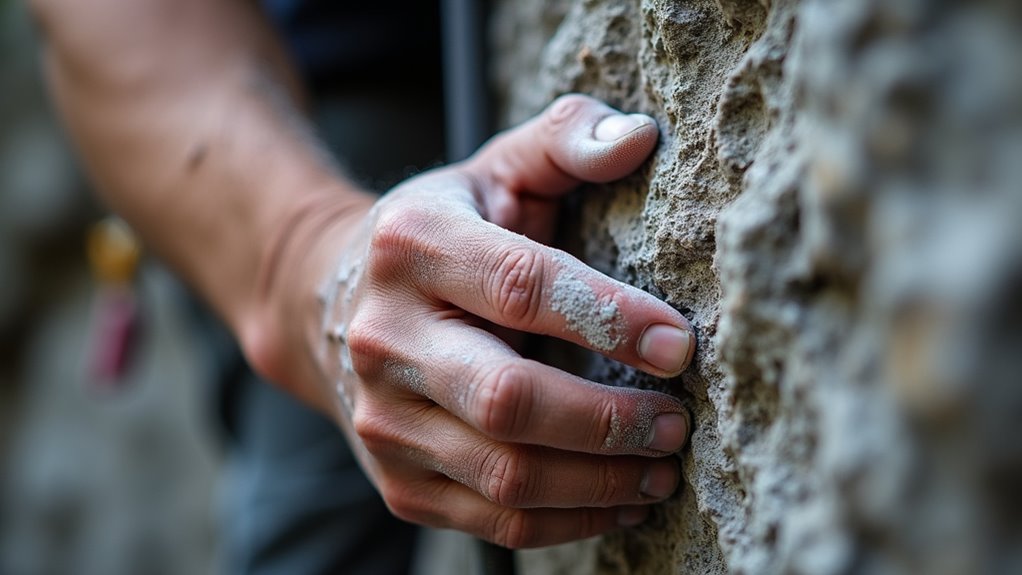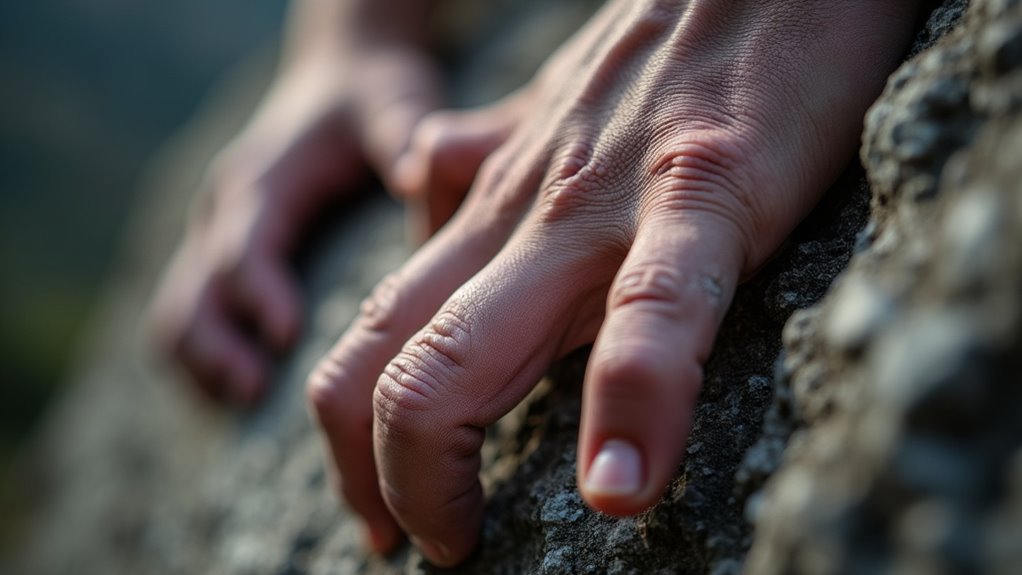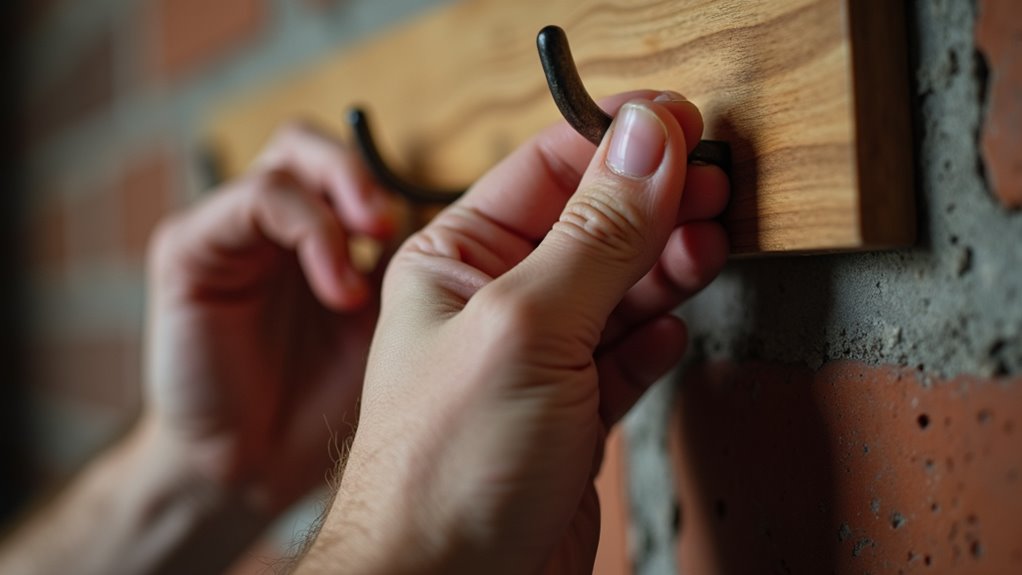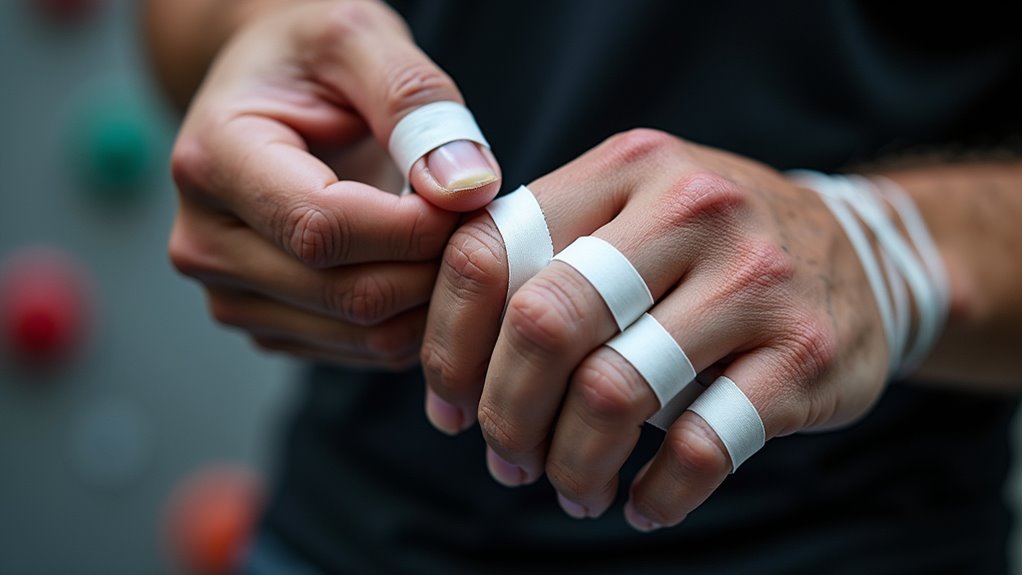Physical Address
304 North Cardinal St.
Dorchester Center, MA 02124
Physical Address
304 North Cardinal St.
Dorchester Center, MA 02124

Nobody expects these 6 unconventional skin-toughening secrets that transform tender fingertips into bulletproof climbing tools within weeks.
It’s funny how you’re researching skin toughening just as climbing season peaks—most climbers face this exact challenge right now. You’ve probably noticed your fingertips splitting after just a few routes, turning what should be an epic day into a painful struggle. Here’s the thing: toughening your skin isn’t about enduring more pain or climbing through injuries. There’s actually a strategic approach that’ll transform your soft fingertips into climbing-ready tools without the unnecessary suffering you’re currently experiencing.

Since your skin needs time to adapt to the demanding friction of rock climbing, you’ll want to begin with shorter sessions and lighter grips rather than jumping straight into aggressive routes.
Start with 30-45 minute sessions, focusing on easier grades that don’t require death grips on sharp holds.
Gradually increase your climbing time by 15 minutes each week while slowly tackling more challenging routes. This progressive approach lets your skin develop calluses naturally without tearing or excessive wear.
Pay attention to how your fingertips feel during and after climbing. If they’re getting raw or painful, back off immediately.
Your skin will strengthen faster with consistent, moderate exposure than with sporadic intense sessions that leave you nursing torn skin for days.
Building tough skin through gradual exposure works hand-in-hand with proper daily maintenance of your hands. You’ll want to moisturize immediately after climbing sessions while your skin’s still warm and pores are open. Use climbing-specific balms containing lanolin or beeswax rather than regular lotions that can make your hands too soft.
Clean your hands thoroughly before moisturizing to remove chalk residue and dirt that can clog pores. Apply thin layers and let them absorb completely. Don’t over-moisturize – you’re aiming for supple, resilient skin, not baby-soft hands.
Trim hangnails and file rough edges to prevent tears that’ll sideline your training. Keep cuticles healthy but not overly soft. The goal is creating a protective barrier while maintaining the grip-friendly texture you need for holds.
Consider using warm bags during cold weather climbing sessions to maintain hand flexibility and prevent skin from becoming too brittle.

Three specific exercises can toughen your hands and fingers between climbing sessions without needing a rock face or climbing wall.
First, rice bucket training builds finger strength and skin resilience. Fill a bucket with uncooked rice and practice finger movements, pinches, and grips for 10-15 minutes daily. The rice’s abrasive texture gradually thickens your skin while strengthening tendons.
Second, stress ball squeezes target grip strength and callus development. Use a firm stress ball or tennis ball, squeezing repeatedly throughout the day. Focus on finger pads and palm contact points.
Third, hang board training conditions fingertips through controlled exposure to holds. Start with larger holds and shorter durations, gradually progressing to smaller grips. You’ll develop both strength and skin thickness simultaneously through consistent practice.
Just like considering whether to rent or buy equipment for other outdoor activities, climbers should evaluate their commitment level before investing in expensive training equipment.
While indoor climbing walls offer convenience, outdoor rock faces provide the best natural conditioning for your skin. Start with sandstone routes when you’re building skin thickness. The rough texture gradually toughens your fingertips without causing excessive damage.
Limestone’s sharp edges can slice tender skin, so save these climbs for after you’ve developed calluses.
Granite offers excellent middle ground – it’s abrasive enough to condition skin while remaining forgiving. Quartzite provides similar benefits with slightly more grip texture. Avoid volcanic rock like basalt initially, as it’s often razor-sharp and destroys skin quickly.
Progress systematically through rock types. Begin with shorter routes on gentler stone, then advance to more challenging textures as your skin adapts and thickens naturally. Consider bringing a portable camping toilet for extended outdoor climbing sessions where facilities aren’t readily available.

Although taping might seem counterproductive to skin development, strategic protection actually accelerates the toughening process by preventing catastrophic skin loss. You’ll want to tape before your skin reaches the breaking point, not after damage occurs.
Use cloth athletic tape for maximum grip retention. Apply it only to high-wear areas like finger tips and knuckles. Keep the tape thin—multiple layers reduce sensitivity and control. Remove tape immediately after climbing to let your skin breathe and adapt.
For crack climbing, consider fingerless gloves or crack gloves during training sessions. They’ll protect against deep cuts while still allowing callus formation.
Just like researching gear before making a purchase, avoid common mistakes when selecting your taping method by testing different tape types during shorter sessions first.
Between climbing sessions, your skin undergoes the critical adaptation process that actually builds toughness. You can’t rush this healing period—forcing another session too early will tear fragile new skin and set back your progress.
Give your hands 24-48 hours between intense sessions. During recovery, keep your skin clean but don’t over-wash with harsh soaps that strip natural oils. Apply a thin layer of climbing-specific balm or basic moisturizer before bed to prevent excessive drying and cracking.
Avoid picking at flaps or calluses—let them naturally integrate into your skin’s structure. Light finger exercises and gentle stretching maintain mobility without stressing healing tissue.
Stay hydrated and eat protein-rich foods to support cellular repair. Quality sleep accelerates the entire recovery process.
Consider carrying a small survival card with essential recovery reminders and techniques to reference between sessions when you’re away from home.
Your skin will become absolutely bulletproof if you follow these six strategies consistently. Don’t expect overnight results—building climbing-tough skin takes weeks of deliberate practice. Stay patient with the process, listen to your body’s signals, and you’ll develop the resilient hands every serious climber needs. Remember, there’s no shortcut to bulletproof skin, but these proven methods will get you there faster than random hope and prayer.